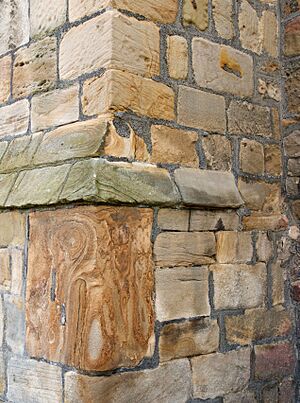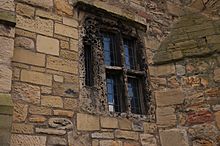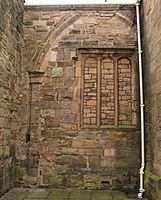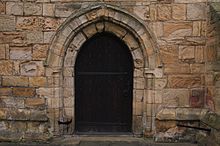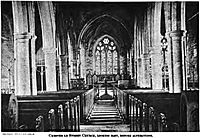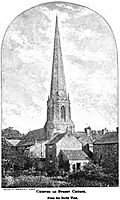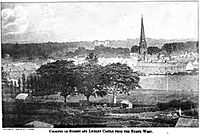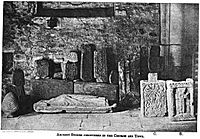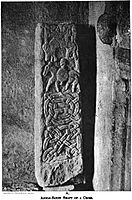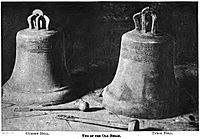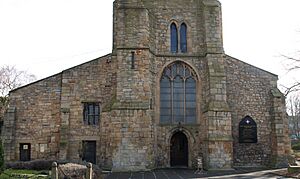St Mary and St Cuthbert, Chester-le-Street facts for kids
Quick facts for kids St Mary and St Cuthbert |
|
|---|---|
| Parish church of St Mary and St Cuthbert | |
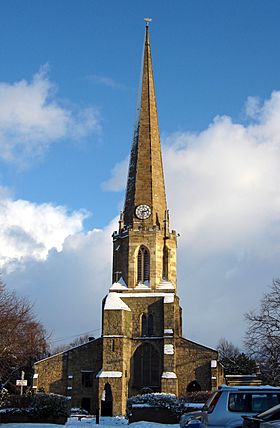 |
|
| Lua error in Module:Location_map at line 420: attempt to index field 'wikibase' (a nil value). | |
| OS grid reference | NZ 274 513 |
| Location | Chester-le-Street, County Durham |
| Country | England |
| Denomination | Church of England |
| Website | https://www.maryandcuthbert.org.uk |
| History | |
| Status | Parish church |
| Dedication | St Mary and St Cuthbert |
| Past bishop(s) | Bishop of Lindisfarne |
| Administration | |
| Diocese | Durham |
The St Mary and St Cuthbert church is a Church of England church. You can find it in Chester-le-Street, County Durham, England. People have worshipped on this spot for over 1100 years. Some parts of the church building are more than 950 years old! The oldest English translation of the Gospels was made here. A scribe named Aldred translated them between 947 and 968. At that time, this church was a very important Christian center.
Contents
St Cuthbert's Journey and Community
This church was first built to keep the body of Cuthbert of Lindisfarne. He was a Bishop of Lindisfarne from 684 to 687. After he died, he became a very respected saint. Many people followed his teachings. The famous writer Venerable Bede even wrote two books about him.
Monks Flee Vikings
In 875, Viking raiders forced the monks to leave Lindisfarne. They took St Cuthbert's coffin and other valuable items with them. The monks traveled for seven years. Finally, in 883, they settled in Chester-le-Street. This place was then called Cunecaster or Conceastre. It was built on the site of an old Roman fort called Concangis. Guthred gave them the land.
Building the First Church
The monks built a wooden church and a special shrine for St Cuthbert's relics. They named it St Mary and St Cuthbert. There was plenty of stone from the old Roman fort. But they chose not to build a stone church. Maybe they didn't plan to stay there for so long. The church was inside the Roman fort. This fort might have offered some protection. It also gave access to roads and the River Wear.
A Center of Christianity
This church was also a cathedral. It held the bishop's seat. The diocese (church area) stretched from Teesside in the south to Lothian in the north. It also reached the Irish Sea in the west. Alfred the Great confirmed the bishop's power. The community stayed here for 112 years. Kings Æthelstan and Edmund visited and left gifts. These gifts added to the treasures from Lindisfarne.
The Lindisfarne Gospels
The Lindisfarne Gospels were among their most important treasures. They were created in Lindisfarne around 715. While at Chester-le-Street, they were translated from Latin into English. This happened between 947 and 968. Aldred wrote notes in Old English above the Latin text. This makes them the oldest English translation of the Gospels. The Gospels and St Cuthbert's coffin stayed here until 995. More Viking raids forced the monks to leave again. They went to Ripon and then to Durham. In Durham, they built a stone cathedral for St Cuthbert's remains. The wooden church in Chester-le-Street was replaced by a stone church in the mid-11th century.
Church Building History
The oldest parts of the church we can still see today date back to 1056. That's when a stone church was built. It replaced the first wooden shrine to St Cuthbert. These parts include the walls of the chancel and two large pillars in the nave. The church back then was much smaller. It was a third shorter and as wide as the chancel is now. You can see special holes called lewis holes in some stones. These show that Roman stones were reused in later building work.
Later Additions and Changes
The church was made bigger around 1267. The nave, the lower part of the tower, and the east wall are from this time. In 1286, it became a collegiate church. This meant it had a dean, canons, chaplains, and deacons. They were supported by money from a large parish. Around 1383, a small room called an anchorage was added. Six male anchorites used this room until 1547. An anchorite was a person who chose to live alone in a small room attached to a church. This room is now the Ankers House Museum. In 1409, a 158-foot (48-meter) spire and belfry were added. Three bells were also installed. One of these bells is still used today!
Reformation and Donations
During the Reformation, the collegiate church system ended. The church became a regular parish church. It had less money and influence. Over the years, many donations helped with building work. The Lumley and Lambton families gave a lot. In 1595, John Lumley added statues of his family. These statues are now along the north wall. A new south porch was built in 1742. In 1829, a special pew for the Lambton family was added. It was designed by Ignatius Bonomi. This pew was above a new vault.
Victorian Restoration and Modern Era
Major repairs and updates happened in 1862. This is known as the Victorian restoration. The church became a rectory when an organ was installed in 1865. This organ was later fixed by Harrison & Harrison. In 1883, a screen was added to celebrate the church's 1000th anniversary. Other changes were made too. In 1927, a special screen behind the altar (called a reredos) and other decorations were added. These were designed by Sir Charles Nicholson. His brother, Archibald Keightley Nicholson, added three panels showing Journey of St Cuthbert's body. In 1950, the church became a Grade I listed building. This means it's a very important historic building. Doors were added to the South Porch in 1964.
Church Details
List of Important People
This church has had many important leaders over the centuries.
Bishops
- Eardulf (883-900)
- Cutheard (900-915)
- Tilred (915-928)
- Wigred
- Utchred
- Sexhelm (947)
- Aldred
- Elfsig
- Aldune
Deans
- Mervin
- Waleran
- Iolanus
- Robert
- Waleran
- Robert le Bursar
- Walter de Clifford
- Magister Alan de Esingwalde
Rectors
- William de Marclan
- Roger de Gillyng
- John de Sculthorpe
- John de Kyngeston
- John de Derby
- Thomas de Hexham
- John de Ashbourn
- John de Newton
- John Bawdwyn
- John Balswell
- Robert Chamber
- Thomas Keye
- Richard Layton
- William Warren
Perpetual Curates
- George Brome
- William Massey
- Bryan Adamson
- Thomas Lyddall
- Robert Willis
- Robert Hunter
- William Hume
- Edmund Browne
- Nicholas Conyers
- Nathaniel Chilton
- William Lambe
- Francis Milbanke
- Lewis Powell
- John Nelson
- William Nesfield (1789-1828)
- Thomas Hyde Ripley (1828-1865)
- Robert Kirwood (1865-1872)
- Canon William Octavius Blunt (1872-1895)
- Alrued Bayford de Moleyns (1895-1919)
- Canon Frank Hilton Jackson (1919-1936)
- Hubert Seed Wilkinson (1936-1940)
- Canon Charles Reginald Appleton (1940-1958)
- Anthony Spurr (1959-1971)
- Patrick Allen Blair (1971-1977)
- Ian Bunting (1978-1987)
Burials at the Church
Some notable people are buried at St Mary and St Cuthbert's.
- John Lambton, 1st Earl of Durham
- Ralph de Lumley, 1st Baron Lumley
Millenary Festival: 1000 Years of History
In 1883, the church celebrated its 1000th anniversary! This "millenary festival" took place from July 18 to August 5. To mark this special event, the church got a big makeover. New oak stalls and an oak screen were added. There was also a new dossal (a cloth behind the altar) and other hangings. These were designed by C. E. Kempe. The Earl of Scarbrough gave a new pulpit. A new marble floor and other improvements were also made. Many of these were gifts for the celebration.
Many other events happened during the festival. A book was published to tell the story of the church's first thousand years. The Bishop of Durham, J. B. Lightfoot, attended the celebrations. He even led a service to dedicate the new bells.
- Images from 1883
-
A view over Chester-le-Street towards Lumley Castle.
-
The shaft of an Anglo-Saxon cross, now at The Ankers house.
Church Bells
The church's bell tower is over 600 years old! It first held three bells. In 1883, a new set of six bells was made. These were cast by John Taylor & Co in Loughborough. Two of the old bells were melted down and their metal was used in the new ones. In 1908, two more bells were added, making a total of eight. These bells are used for change ringing, a special way of ringing bells in patterns. One of the original bells from 1409 still exists. It's called an "odd ninth" and is used as a service bell. This bell is very important historically. The bells are rung before Sunday services. People also practice ringing them on Friday evenings.
The Lindisfarne Gospels at the Church
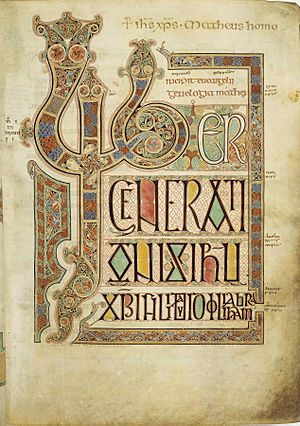
The Lindisfarne Gospels were kept in Durham until 1539. During the Dissolution of the Monasteries, St Cuthbert's shrine was looted. The Gospels were then taken to London. Today, they are kept at the British Library. However, a copy of the Gospels is kept at St Mary and St Cuthbert's church. You can see this copy when the church is open.
The Anchorage and Ankers House Museum
Attached to the church is a special room called the former anchorage. It's one of the few anchorages still existing today. It's even called the most complete example in England! It was made by blocking off a corner of the church in the late 14th century. An extra room was added outside in the 16th century. It used to have two levels, but the floor was removed to create more space and light.
Life of an Anchorite
From 1383 to 1547, six anchorites lived here. An anchorite was a person who chose to live a life of prayer and solitude. They were walled into the anchorage for life. They could watch church services through a small opening called a squint. This squint looked down onto a side altar. They received food through another small opening to the outside.
The Museum Today
The anchorage was used this way until the Reformation. After that, it was sometimes used by poor people or church members. In 1986, it became the Ankers House Museum. It's one of the smallest museums in the UK! The museum shows what life was like for an anchorite. It also displays items found on the site. These items include things from Roman, Anglo-Saxon, and medieval times.


